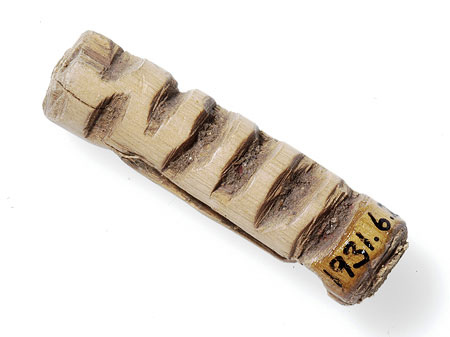Accession Number:
1931.6.2 .1 .2
Country:
Sudan
Region:
[Southern Sudan]
Cultural Group:
Lango
Date Made:
By 1931
Materials:
Wood Plant , Pottery
Process:
Carved , Incised , Decorated , Impressed
Dimensions:
L [.1] = 32.9, W [.1] = 8.6, th [.1] = 8.2 mm [RTS 18/10/2004] Max L [.2] = 51 mm
Weight:
1.1 g
Local Name:
aked or agor?
Other Owners:
Collected by T.A.C. Rubie, passed onto PRM via Mr Driberg [?Jack Herbert Driberg].
Field Collector:
?T.A.C. Rubie
PRM Source:
T.A.C. Rubie via Mr Driberg [?Jack Herbert Driberg]
Acquired:
Donated 1931
Collected Date:
By 1931
Description:
Small roulette for decorating pottery, carved from a single piece of pale yellow wood (Pantone 7507C) and consisting of a cylindrical body with ovoid section, cut roughly flat at either end.
The body has been decorated with several deeply incised grooves, with the pattern consisting of two vertical lines, turning in towards one another at the top, and joining in a horizontal bar across their base; this covers one half the length of the cylinder.
On the opposite side, is a vertical column composed of five parallel lines running around the width, and at the top, a further two lines that are slightly staggered and not in alignment with the group below.
The cutting is somewhat irregular in execution; the grooves are filled with a darker material.
When impressed into clay, this roulette would create a repeating design of a large U-shape, possibly representing horns, alternating with a column of dashes.
The object is complete, but there is some splitting of the wood along its length.
It has a weight of 1.1 grams, is 32.9 mm long, 8.6 mm wide and 8.2 mm thick.
Each groove is around 2 mm wide.
Collected by T.A.C. Rubie in the Southern Sudan, and passed onto the Pitt Rivers Museum via Jack Herbert Driberg in 1931.
Driberg discusses pottery manufacture amongst the Lango: "Pottery is not confined to a manufacturing class, but pots are made by the males of the family as required, the women fetching the clay ( dagi) from the riverbeds ... The clay is used unmixed, and the smaller pots are moulded by hand from the lump. In the case of the larger pots the base is moulded and the pot is gradually built up by successive strips of clay. When it is finished the pot is left for three or four days until quite dry, and then thickly wrapped in grass, which is fired from the base upwards. While the pot is still damp a small piece of stick ( aked or agor) about one and a half inches long and spirally fretted is rolled over it to impress such patterns as the maker may choose, and the inside of the pot is gently smoothed with a calabash scraper called akwaya. " (J.H. Driberg, 1923, The Lango, p. 88).
For other Lango roulettes, see 1931.6.1 and 1931.6.3-4. Other tribes that use roulettes to decorate their pottery include the Dinka Tuich (1979.20.125-6), Moru Misa (1979.20.27-28) and northern Larim (1979.20.149). These are usually made of plaited grass.
Rachael Sparks 29/8/2005.
Collected by T.A.C. Rubie in the Southern Sudan, and passed onto the Pitt Rivers Museum via Jack Herbert Driberg in 1931.
Driberg discusses pottery manufacture amongst the Lango: "Pottery is not confined to a manufacturing class, but pots are made by the males of the family as required, the women fetching the clay ( dagi) from the riverbeds ... The clay is used unmixed, and the smaller pots are moulded by hand from the lump. In the case of the larger pots the base is moulded and the pot is gradually built up by successive strips of clay. When it is finished the pot is left for three or four days until quite dry, and then thickly wrapped in grass, which is fired from the base upwards. While the pot is still damp a small piece of stick ( aked or agor) about one and a half inches long and spirally fretted is rolled over it to impress such patterns as the maker may choose, and the inside of the pot is gently smoothed with a calabash scraper called akwaya. " (J.H. Driberg, 1923, The Lango, p. 88).
For other Lango roulettes, see 1931.6.1 and 1931.6.3-4. Other tribes that use roulettes to decorate their pottery include the Dinka Tuich (1979.20.125-6), Moru Misa (1979.20.27-28) and northern Larim (1979.20.149). These are usually made of plaited grass.
Rachael Sparks 29/8/2005.
Primary Documentation:
Accession Book Entry
[p.
472] [insert, pencil] 6 [end insert] -
T.A.C.
Rubie
, Esq., (Through the kindness of Mr Driberg, 8 Tavistock Pl., W.C.1).
[insert, pencil] 1-4 [end insert] - [1 of] 4 small carved wooden rollers used in decorating pottery by the LANGO tribe, EASTERN SUDAN.
Card Catalogue Entry - There is no further information on the catalogue card [RTS 24/5/2004].
Old Pitt Rivers Museum label - 4 carved wooden rollers, LANGO tribe, EASTERN SUDAN. Colld & pres. by T.A.C. Rubie, 1931 [Rectangular card label stuck to black card used as a mount for the rollers, which were glued to the card. When found on 24/5/2004, two of the four rollers had become detached from their mount. The group was separated from the mount in October 2004. RTS 18/10/2004].
Card Catalogue Entry - There is no further information on the catalogue card [RTS 24/5/2004].
Old Pitt Rivers Museum label - 4 carved wooden rollers, LANGO tribe, EASTERN SUDAN. Colld & pres. by T.A.C. Rubie, 1931 [Rectangular card label stuck to black card used as a mount for the rollers, which were glued to the card. When found on 24/5/2004, two of the four rollers had become detached from their mount. The group was separated from the mount in October 2004. RTS 18/10/2004].






